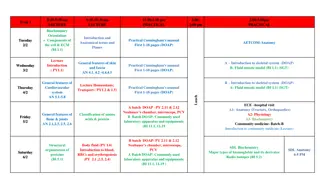Understanding Plasma Proteins and Their Functions
Plasma proteins play a crucial role in various physiological functions such as controlling extracellular fluid distribution and transportation of hormones, vitamins, and other substances. The balance between protein synthesis and catabolism determines protein levels in the vascular compartment, affe
6 views • 23 slides
Understanding Extracellular Matrix (ECM) and Its Functions
Extracellular Matrix (ECM) is a complex network of proteins, glycoproteins, and macromolecules that provide structural support, regulate cell activities, and play crucial roles in various tissues. It consists of two main types - interstitial matrix and basement membrane, each serving specific functi
12 views • 25 slides
Understanding Physiological Acid-Base Balance in Pharmaceutical Inorganic Chemistry
This lecture delves into the fundamental concepts of pharmaceutical inorganic chemistry, focusing on the mechanisms and uses of various pharmaceutical products that correct body disorders. Topics covered include acids and bases, intra and extracellular electrolytes, and the role of buffers in mainta
10 views • 14 slides
Regulation of Extracellular Fluid Volume in Renal Physiology
This lecture focuses on the mechanisms involved in the regulation of extracellular fluid volume, primarily highlighting the role of sensors, effectors, and the kidney in maintaining body fluid balance. It discusses the importance of regulating extracellular fluid volume and osmolarity for controllin
0 views • 25 slides
Pharmacy Practice: Percentage and Ratio Strength Calculations
Understanding percentage and ratio strength calculations is crucial in pharmacy practice. Percentages can be expressed as fractions or decimals, and various concentrations like weight-in-volume and volume-in-volume are used in pharmaceutical preparations. Learn how to calculate the correct strength
0 views • 24 slides
Plasma Exchange in Treatment of PANS - Overview and Considerations
Plasmapheresis, a type of apheresis, plays a crucial role in managing Pediatric Acute-onset Neuropsychiatric Syndrome (PANS) and Pediatric Autoimmune Neuropsychiatric Disorders Associated with Streptococcal Infections (PANDAS). This treatment involves separating the extracellular component of blood
0 views • 26 slides
Understanding Mechanisms for Concentrating & Diluting Urine in Maintaining ECF Osmolarity
Explore the intricate processes involved in concentrating and diluting urine to regulate extracellular fluid (ECF) osmolarity through mechanisms like the loop of Henle and vasa recta. Understand the factors influencing the ability to create a concentrated medullary gradient, differentiate water diur
0 views • 26 slides
Regulation of Extracellular Fluid Volume: A Comprehensive Overview
Understanding the intricate mechanisms involved in the regulation of extracellular fluid volume is essential for maintaining normal body function. This includes sensor and effector roles in renal regulation, the influence of aldosterone on Na+ reabsorption, the significance of Na+ balance, and the i
3 views • 22 slides
Understanding Density and Specific Gravity in Pharmacy Practice
Density and specific gravity are important concepts in pharmacy practice for measuring mass and volume relationships of substances. Density is the mass per unit volume of a substance, usually expressed in grams per cubic centimeter, while specific gravity is the ratio of the weight of a substance to
0 views • 21 slides
Cell Communication and Signalling in Biology
Cells communicate through extracellular signalling molecules that bind to specific receptors on target cells, leading to changes in cellular behavior. Hormones such as steroid and peptide hormones, neurotransmitters like nor-adrenaline and acetylcholine, play crucial roles in cell signaling. Recepto
0 views • 25 slides
Understanding Gas Laws: Boyle's, Charles', Gay-Lussac's, and Avogadro's Laws
Gas laws such as Boyle's Law, Charles' Law, Gay-Lussac's Law, and Avogadro's Law govern the behavior of gases under different conditions. Boyle's Law relates pressure and volume at constant temperature, Charles' Law relates volume and temperature at constant pressure, Gay-Lussac's Law relates pressu
1 views • 19 slides
Understanding Packed Cell Volume (PCV) and Haematocrit (HCT) Testing
Packed Cell Volume (PCV) or Haematocrit (HCT) is a blood test that measures the volume of red blood cells as a percentage of total blood volume. High or low values can indicate specific health conditions like dehydration or anemia. The test is important in diagnosing conditions like polycythemia. Me
0 views • 14 slides
Understanding Mass, Volume, and Density in Science
Discover the essential concepts of mass, volume, and density in science. Learn how to differentiate between these terms, their units of measurement, and their significance in understanding the physical properties of objects. Explore the importance of mass in determining the amount of matter, the con
0 views • 16 slides
Understanding Physiology: The Science of Living Organisms
Physiology is the study of processes and functions in living organisms, encompassing various disciplines such as physics, chemistry, and mathematics. It delves into the intricate regulation and maintenance of internal environments within our bodies, vital for optimal cell, tissue, and organ function
4 views • 15 slides
Understanding Body Fluids and Composition in the Human Body
The body composition of an average young adult male includes protein, mineral, fat, and water in varying proportions. Water is the major component, with intracellular and extracellular distribution. Movement of substances between compartments occurs through processes like simple diffusion and solven
0 views • 37 slides
Understanding Major Intra and Extracellular Electrolytes in Body Fluids
Body fluids contain various electrolytes crucial for maintaining cell and tissue environments. Electrolyte balance is essential for overall health, and external electrolyte replacement therapy may be necessary in certain conditions. The body's fluid compartments - intracellular, interstitial, and pl
0 views • 10 slides
Understanding Fluid Therapy in Animals: Basics and Indications
Explore the fundamental concepts of body fluids in animals, including their composition, types, routes of administration, and signs of fluid overload. Delve into the balance of intracellular and extracellular fluids, daily water intake and loss, and the role of electrolytes. Dr. Bipin Kumar provides
0 views • 33 slides
Understanding Renal Regulation of Body Fluids
Renal regulation of body fluids involves mechanisms like water diuresis and osmotic diuresis to maintain fluid balance in the body. The secretion of Anti-Diuretic Hormone (ADH) plays a crucial role in controlling water retention. ADH release is influenced by factors like blood volume, blood pressure
0 views • 18 slides
Understanding Density and Physical Properties of Matter
Matter possesses physical properties that can be observed without changing its identity, including color, shape, length, mass, volume, and density. Density is the amount of mass per unit volume, where D = m/V. Objects with the same volume but different masses can have varying densities. Density can
1 views • 7 slides
Understanding Water and Electrolyte Balance in the Human Body
The body's fluid compartments, including intracellular and extracellular fluids, play a crucial role in maintaining water and electrolyte balance. This balance is regulated by movements of water and electrolytes between compartments, influenced by factors like hydrostatic and osmotic pressures. Main
2 views • 18 slides
OpenStack Cinder Storage Capabilities Overview
OpenStack Cinder provides persistent block storage resources for cloud environments with support for multiple back-ends and over 100 volume drivers. This overview covers key features like volume migration, volume retype, generic volume cache, replication, volume groups, backup, and restore. Addition
1 views • 29 slides
Understanding Mass, Volume, and Density in Physics
Matter, which makes up the universe, has mass and volume. Learn the differences between mass and volume, and weight, as well as how to measure them accurately. Discover why a ton of bricks and a ton of feathers have the same mass but different volume. Understanding the concepts of mass, volume, and
3 views • 12 slides
Role of Adhesion Molecules in Immune Response to SARS-CoV-2 Engagement
Engagement of SARS-CoV-2 triggers the complement system and TLR 7 in neutrophils and macrophages, leading to the release of inflammatory cytokines and chemotactic factors. This results in the upregulation of adhesion molecules on blood capillary endothelial cells and leukocytes, facilitating leukocy
3 views • 12 slides
Operational Guidelines for Implementing World Programme for the Census of Agriculture 2020 Volume 2
Proposed outline of Volume 2 presented at a technical review meeting in Rome, Italy. The purpose of Volume 2 is to provide comprehensive guidance on preparing and conducting agricultural censuses, with detailed steps on developing the census chapter, planning, methodology, and implementation. The st
5 views • 12 slides
Overview of Histology: Study of Tissues and Organs
Histology involves studying the tissues of the body and how they form organs. Tissues consist of cells and extracellular matrix, with functions like support, nutrient transport, and waste removal. The human body comprises epithelial, connective, muscular, and nervous tissues, each with specific func
0 views • 4 slides
Understanding Tissues: Types, Characteristics, and Functions
Explore the intricate world of histology and tissues, where groups of cells with similar structures and functions come together to support various bodily processes. From epithelial to nerve tissues, delve into the differences in tissue classes, cell types, and extracellular matrices. Discover the un
0 views • 74 slides
Understanding Epithelial Tissue in General Histology
Epithelial tissue is a crucial type of tissue in the human body, performing functions like protection, absorption, secretion, and sensation detection. This tissue is composed of cells with minimal extracellular matrix and plays a vital role in various bodily processes. Learn about the classification
0 views • 47 slides
Biochemistry Orientation, Cell Components, Anatomical Terms, and Practical Sessions Week 1
Delve into the world of Biochemistry with an orientation on cell components and the Extracellular Matrix (ECM). Explore anatomical terms and planes, setting the foundation for further learning. Engage in practical sessions using Cunningham's manual for hands-on experience in the field. Week 1 is pac
0 views • 38 slides
Biological Modeling of Neuronal Networks: Insights from Neural Dynamics
Exploring neuron models, generalized linear models, and decoding processes in neural networks through intracellular and extracellular recordings, with a focus on processing models, encoding, and decoding of spike trains. The Spike Response Model and likelihood of spike trains are discussed, providin
0 views • 32 slides
Understanding Tissue Repair Mechanisms: Regeneration and Fibrosis
Tissue repair involves complex mechanisms like regeneration by parenchymal cells or fibrosis leading to scar formation. Inflammatory cells play a crucial role in tissue repair, along with processes like ECM synthesis and cell migration. Different types of cells in the body have varying regenerative
0 views • 20 slides
Tissue Regeneration, Repair, and Inflammation Explained
Tissue regeneration and repair processes involve either regeneration of cells or connective tissue repair, depending on the type of cells injured. In cases where regeneration is not possible, healing occurs through the formation of scar tissue. The healing process aims to restore the structural cont
0 views • 40 slides
Understanding Hematopoiesis and White Blood Cells in Blood Formation Process
The process of hematopoiesis involves the lifelong production, multiplication, and specialization of different blood cells in the bone marrow, starting with the stem cells. This process includes the differentiation and proliferation of various progenitor cells, regulated by hematopoietic growth fact
0 views • 27 slides
Understanding Volume in Mathematics: A Comprehensive Guide for Students
This comprehensive guide delves into the topic of volume in mathematics for students. It covers the importance of volume in daily life, how to find the volume of various solid objects using formulas, solving volume-related problems, and applying volume concepts in real-life scenarios. The guide also
0 views • 35 slides
Understanding Volume Measurement in Metric Units
Explore the concept of volume measurement in metric units through lessons on English vs. metric units, measuring liquid volume with graduated cylinders, and calculating solid volume using formulas. Understand the relationship between liters, milliliters, and other units, and learn practical techniqu
0 views • 6 slides
Understanding Traffic Engineering Studies in Civil Engineering
Traffic engineering is a crucial aspect of transportation engineering that encompasses planning, design, and operation of roads, streets, and highways. It involves analyzing traffic volume, speed studies, parking patterns, traffic flow characteristics, accident studies, and more. Traffic volume stud
1 views • 37 slides
Unit Conversion and Calculation Practice with Length, Mass, Volume, and Density
Practice various unit conversions and calculations involving length, mass, volume, and density using conversion factors such as inches to centimeters, pounds to kilograms, and quarts to liters. Solve problems like converting marathon distance from miles to kilometers, determining mass in kilograms f
0 views • 7 slides
Understanding Density and Volume in Science Class
Explore the concept of density and volume in science class through hands-on activities and tests. Learn how to calculate density, mass, and volume, and understand the relationship between volume and mass in solving for density. Practice measuring volume and mass with diverse problems to enhance your
0 views • 35 slides
Understanding Key Factors in Oil and Gas Industry
Explore essential concepts in the oil and gas sector such as oil volume at surface conditions, gas volume at standard conditions, porosity measurement, water saturation, and formation volume factor. Learn how to calculate stock tank oil volume, gas in place, and interpret crucial parameters for rese
0 views • 12 slides
Understanding the Lymphatic System: Functions and Importance
Lymph is a clear, colorless fluid that plays a crucial role in maintaining the body's fluid balance, immune response, and lipid absorption. The lymphatic system functions to return excess fluid and proteins to the bloodstream, aid in immunity through lymphocytes, absorb dietary lipids, and regulate
0 views • 13 slides
Understanding Volume Measurements in Lab Experiments
Explore the world of volume measurements in laboratory settings, delving into the concepts of volume in both metric and imperial systems. Learn about factors to consider in liquid measurements, techniques for measuring liquids accurately, and the use of domestic measures in drug administration. Disc
0 views • 11 slides







































